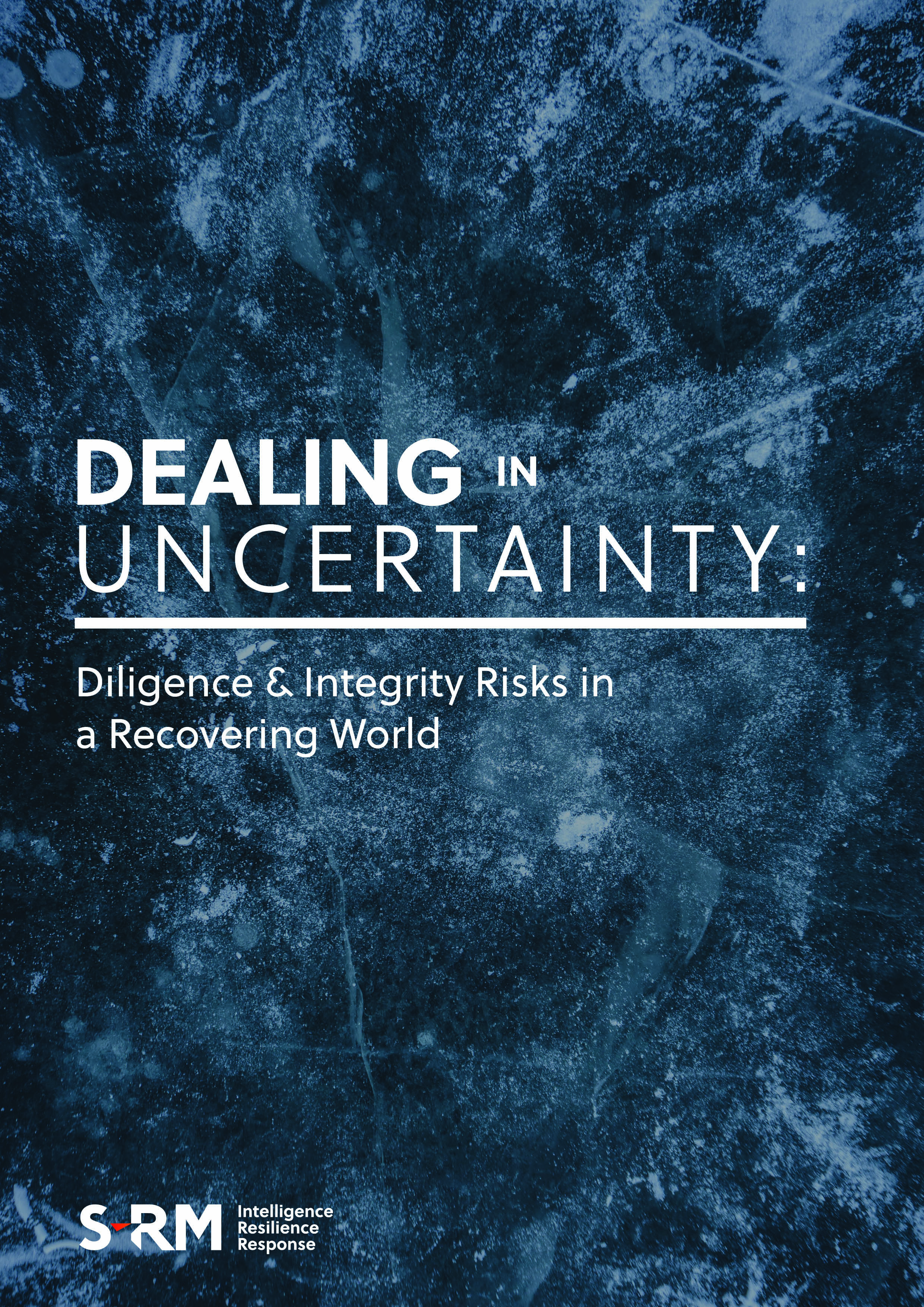Cents on the Dollar: Insolvency, Asset Tracing and Recovery in an Economic Downturn
The COVID-19 pandemic – and the government-mandated shutdowns of 2020 – is already seeing economic conditions deteriorate to levels far worse than the last financial crisis. Almost overnight, turnover for whole sectors of the economy fell to zero, while debt and rent payments were still due. The retail, hospitality, energy and automotive industries are expected to be the hardest hit. Already, half a million UK companies are facing insolvency in the first half of 2020.[1] In the US, 722 companies sought bankruptcy protection in May 2020 alone – an increase of 48% from the same period a year prior.[2] Most of these insolvencies will be process-driven and relatively straightforward. However, in a minority of cases, insolvency practitioners (IPs) might need to unpick a fraud or look beyond the numbers on the balance sheet for assets to recover. In these circumstances, it is critical that the IP fulfils its obligations to creditors by assembling a team with the right mix of skills to maximise recovery.
Our team has already been engaged to trace the assets of companies which have failed to pay invoices or honour contracts with subcontractors and suppliers, after their liquidity dried up when their operations screeched to a sudden halt. These clients were forced to move swiftly as a raft of creditors began seizing the most attractive assets, leaving slower movers with a challenging and painstaking path to repayment. Our investigators are providing crucial information to IPs, creditors and their legal teams working to recover funds.
In this article, we examine the contribution that intelligence and investigative work brings to the insolvency process and, in particular, how developments in intelligence industry techniques can facilitate the recovery of assets after insolvency.
Restructuring, Insolvencies and Intelligence
In response to the pandemic, the UK government introduced an urgent insolvency bill which limits the rights of creditors to enforce debts or object to restructuring plans.[3] In most situations, creditors will in any case want to avoid crystallising losses on their balance sheets, and will be pressured into negotiating haircuts on debt. Banks and large landlords are facing intense media scrutiny around their actions to pursue debtors, and we expect many firms to go through constructive, collaborative restructuring processes that attempt to rescue the business. ‘We are looking at multiple insolvencies across a much wider economic sector [than post 2008],’ said Richard Blaksley, an advisor to S-RM who has 30 years of experience investigating fraud and tracing the proceeds.‘This will be boom time for the insolvency profession,’ he notes.
Applying intelligence to the restructuring process |
|
In a restructuring scenario, intelligence can be useful for creditors and other stakeholders as they develop a strategy to maximise their own recovery. In a USD 17.5 billion restructuring in Latin America, S-RM’s local director was brought on board by a creditor to investigate the reputation and likely courses of action that would be taken by regulators, government officials, and a notorious activist investor who had taken a position in the company. Relying on the intelligence we provided to inform its decisions, the creditor was able to subvert the activist investor’s strategies and prevented the activist investor from pushing large losses onto the debt investors. The highly complex restructuring eventually resulted in an outcome for creditors which was unusually favourable for that jurisdiction. |
In a small minority of cases the sudden disappearance of a company’s revenues will expose something more alarming: evidence of negligence, fraud or embezzlement.‘The inevitable post-COVID-19 recession will leave many organisations vividly exposed,’ says Blaksley, adding that ‘stemming internal fraud that had hitherto been a marginal cost could make the difference between survival or failure.’
There may also be evidence that managers and shareholders have transferred assets out of the company shortly before entering formal insolvency measures, to prevent creditors from seizing them. In such cases, recovery can be enhanced by carefully planned investigative work, mapping the counterparties to these transactions and understanding their relationship to the debtor.
Lessons from the aftermath of 2008
By the end of 2019, there were already signs that the financial cycle was reaching its peak. Equity markets had seen years of exuberant gains, and loan covenants were loosening. But some parallels to 2007 were also emerging. The UK saw a wave of retailers, from Debenhams to Mothercare, going into administration in 2019. According to the Insolvency Service, UK personal insolvencies had also risen to levels not seen since 2011, in the aftermath of the 2007-8 financial crisis. It is under these conditions that the world faced a pandemic with unprecedented economic repercussions. Today, as we prepare for the longer-term fallout from COVID-19, a number of important lessons can be drawn from the aftermath of the 2008 financial crisis.
Untangling complex structures
The 2008 recession was partially triggered by the September 2008 bankruptcy of Lehman Brothers, one of the largest US investment banks, with more than USD 600 billion of liabilities globally. It took the trustee more than a decade to analyse 140,000 creditor claims and recover USD 123 billion, with unsecured creditors eventually receiving 39.75 percent of their claims.[4] The sheer complexity of Lehman Brothers’ global operations, which included not only customer accounts and various classes of debt, but also complex financial products such as subprime mortgage backed securities, collateralised debt obligations, and swap and derivatives contracts, created a huge challenge. PwC, as liquidators of Lehman Brothers, relied heavily on specialist intelligence firms to navigate this situation. The most common mandate was to map out relationships between special purpose vehicles in offshore jurisdictions which had been identified as counterparties in open positions that needed to be closed.
‘The 2008 crisis was centred around the financial institutions, with other sectors largely suffering collateral damage as a consequence. This observation does not seek to minimise the severity of what occurred, but the problem stemmed from the systemic failure of a narrow, but important, sector of the economy,’ says Blaksley.‘Most of the additional professional work that flowed to the insolvency and investigative sectors related to the unravelling of transactions with counterparties. It was very much a case of understanding not the transactions – which were so bewilderingly complex that nobody fully understood them – but who the counterparties were at the other end of those transactions or trades. A lot of them were very strange looking entities with no apparent rationale to exist’.
Connecting the dots
In 2019, in the US, there were 60 local and federal enforcement actions against alleged Ponzi schemes, totalling USD 3.2 billion of investor funds: the highest level of actions since 2009. The 2008 recession saw a wave of Ponzi schemes collapse as their architects could no longer attract new investment and lenders to keep fraudulent investment schemes running. The most notorious – and largest – of these, the Madoff Ponzi scheme, has seen an extremely high level of asset recovery; out of the total claims of USD 19 billion, USD 14.3 billion has been recovered.[5] The trustee, Irving Picard, targeted early investors in Madoff’s funds, especially those who had withdrawn billions in “profit”, and whom the trustee alleged should have been aware of the fraud. Picard relied on voidable transactions clauses in US bankruptcy law (which can be used to claw back assets and funds transferred out of a company shortly before it is declared bankrupt) filing thousands of lawsuits against net beneficiaries of the scheme, including in offshore jurisdictions such as British Virgin Islands (BVI) and the Cayman Islands.
Unusually, Madoff cooperated with the trustees and authorities to identify assets, including those held by family members. However, in most fraudulent insolvencies, documentation is incomplete or deliberately withheld by fraudsters, and outside investigations are needed to identify beneficiaries of voidable transactions and demonstrate their links to the insolvent company. Directors and shareholders who transfer assets out of a company may put these in the name of a family member, or somebody less easily identifiable.
In most fraudulent insolvencies, documentation is incomplete or deliberately withheld. Outside investigations can identify beneficiaries of voidable transactions and demonstrate their links to the insolvent company.
Case in Point: Tradex Ltd |
|
In the absence of a contrite and cooperative fraudster, investigative work is essential. This was the case with Tradex Ltd, a Dominican company at the centre of an earlier Ponzi scheme orchestrated by US preacher Arthur Ferdig until the company’s insolvency in April 2004. Investigators led by BVI-based lawyer Martin Kenney spent years tracing assets and addresses associated with Ferdig, his family and his associates, who went into hiding and blocked the investigation at every turn. The investigation team reviewed thousands of documents, ultimately untangling a network of companies in the Bahamas, Jamaica, the US, Antigua, the Cayman Islands, Canada and Singapore. Their efforts, which led to the eventual recovery of more than USD 10 million, were only made possible through close cooperation with Tradex Ltd’s liquidator, PwC. The liquidator used a broad range of disclosure powers – such as Norwich Pharmacal and Anton Piller orders – to obtain the documents along with seal and gag orders to keep the disclosure secret, before passing them on to the investigative team.[6] |
Selecting potential targets for litigation in aid of asset recovery should also be informed by investigative insights, to avoid wasting the limited funds available for recovery. Asset tracing will underpin the litigation strategy, firstly by identifying major assets in friendly jurisdictions which could be targeted early on. This might fund ongoing efforts to pursue the more difficult beneficiaries who will use complex structures to protect their assets and fight the recovery process.
Technology speeds up investigative work
Since the mid-2000s, technology and the ever-increasing pool of data online has transformed the investigative process, saving time and cutting costs. Investigative teams like the one looking into Tradex Ltd typically had to take hundreds of flights between offshore financial centres to visit records offices, undertake site visits to addresses of interest, and laboriously review documents. Although the investigative process remains the same – searching for patterns, anomalies and leads – we can now replicate much of this research using desktop tools.
Most countries have digitised and made searchable important records – such as corporate filings, property deeds, political donations, and shipping data – although the level of detail varies by jurisdiction. The speed and efficiency of online public record research represents a major step change and increases the efficiency of any on-the-ground enquiries which are still required. This change has been tested and proven in recent months by the intelligence industry’s ability to function effectively despite massive restrictions on international travel or in-country movement.
Open source intelligence is invaluable in bridging the gap between freely available online information and internal company documents.
The development of open source intelligence (OSINT) analysis as a technique has also improved in leaps and bounds. Whether tracking down assets and locations from imprudent social media posts by a friend or family member, analysing satellite imagery or verifying leaked data, OSINT work is invaluable in bridging the gap between freely available online information and internal company documents. With a combination of luck and experience in using the dizzying array of OSINT tools available, major advances in an investigation can be made. For instance, S-RM was recently able to locate the target of an investigation, and a high value residential property, using data from a fitness app posted on social media by a family member.
However, technology is also helping fraudsters transfer funds and incorporate shell companies at the click of a button, as well as launder funds through cryptocurrencies. There is an ongoing “arms race” between fraudsters and investigators in the use of technology. At S-RM, deploying the above-mentioned tools and techniques is the first step in all of our asset tracing assignments, whether pre-litigation or during the enforcement of court judgments or arbitral awards. Understanding the profile of the debtors and their counterparties is critical – and that work needs to incorporate social media analysis, network mapping and background intelligence, often across a wide range of jurisdictions. This provides a platform for more hands-on investigative work, such as tracking down and bringing on board potential witnesses, or conducting surveillance on a target. All of this work ensures that creditors are maximising their cents on the dollar, with no assets being “left on the table".
New Hiding Places and Changing Legal Tools
Meanwhile, pressure on offshore jurisdictions from Panama to Switzerland has increased the level of public disclosure, especially in response to court orders. Corporate records have also become more accessible to the general public, as the more well-established secrecy jurisdictions seek to improve their reputations. Much of the pressure on secrecy jurisdictions has stemmed from the huge data leaks in Panama, the Bahamas and other Caribbean financial centres. This data, although just a snapshot in time, can provide a valuable insight into the offshore activities of debtors and fraudsters. However, the locus of offshore secrecy simply shifts to new markets, not least in US states such as South Dakota and Nevada, as the financial services lobby pushes looser regulations in these jurisdictions.
The UK government is also considering tightening insolvency legislation. In proposed reforms published in August 2018 it suggested extending IPs’ powers to investigate directors and recover assets transferred out of an insolvent company in value extraction schemes, by which third parties strip value from a distressed business. The reforms also envisaged greater accountability for the directors of distressed companies. While Brexit and the pandemic have delayed Parliament’s consideration of this proposal, the changes would be welcome additions to the asset recovery toolkit.
Looking ahead
In the wave of insolvencies to come, a key challenge will be deciding where intelligence expertise can most usefully be deployed. Keeping costs in proportion underlies most decisions made by IPs. But if there is even a suspicion of fraud, not bringing in external intelligence support can often mean failing to untangle webs of companies, transactions and assets, and therefore failing to deliver optimum returns to creditors. By building a true understanding of the people and entities around the debtor – and their interrelationships – the IP avoids overlooking potential value.‘Most creditor-in-possession insolvencies lack the budget to appoint investigators, other than where there is a strong sense of fraudulent trading or preference, and a chance of the relevant transactions being “unwound”,’ concludes Blaksley. ‘Where the insolvency is driven by fraud – think Patisserie Valerie –rather than a general business failure,’ he says, ‘then there should be a much greater role for investigators.’’
The IP has a legal duty to maximise recovery, and without an effort to identify and understand voidable transfers, related parties and evidence of fraudulent activity, the possibility of falling short in this duty is ever present. A successful investigation also relies on building a team with the right skillset, high levels of cooperation, and a mixture of old and new approaches. Investigators who can trace assets globally and map hidden relationships between the protagonists are as central to successful recovery as forensic accountants or local counsel.
A successful investigation relies on building a team with the right skillset, high levels of cooperation, and a mixture of old and new approaches.
CONTENTIOUS INSOLVENCIES AMIDST COVID-19 & THE USE-CASE FOR INTELLIGENCE
 Q&A between Marcus Fishburn, S-RM’s Head of Disputes & Investigations, and Carl Bowles, Head of Contentious Insolvency at Alvarez & Marsal
Q&A between Marcus Fishburn, S-RM’s Head of Disputes & Investigations, and Carl Bowles, Head of Contentious Insolvency at Alvarez & Marsal
Carl Bowles is a Managing Director with Alvarez & Marsal Restructuring in London. He brings 15 years of experience and specialises in offshore, asset tracing and contentious insolvency situations. He has worked in numerous offshore and onshore jurisdictions working on very complex corporate insolvencies and winding down large structures. In addition, Mr. Bowles has also taken appointments as a trustee in bankruptcy in complex cross-border and asset tracing situations. Mr. Bowles is recognized as an asset recovery expert in Who’s Who 2020.
Q: How will this recession differ from the last? Will we see more contentious insolvencies?
A: The last recession was a capital market-driven recession: it was banking-led and it came out of overexposure to subprime assets. The current recession arises from the actual supply and demand of the consumer and of business, and it’s happening on a global scale. There’s been a build-up of what are often called ‘zombie companies’ over the last several years and I think it's now high time for a number of these to be restructured. In any crisis, particularly one as deep as this, you can’t kick the can down the road.
Also, if there is internal fraud taking place, now is when it will get exposed. People are looking at future revenue and at their accounting information much more critically. That in itself unearths fraud within companies, and identifies significant losses which have been covered up. People are also out of the office for a long period of time, and furloughed employees could act as whistle-blowers. So we're expecting a significant increase in the identification of historic fraud as well.
Q: Which sectors do you think will be most severely affected?
A: There are a lot of distressed areas where COVID-19 has accelerated an existing trend in insolvency and restructuring. This has been most visible in the likes of casual dining and retail, certainly the high street, with people changing their spending habits and faced with online alternatives. Although this structural change has been going on for a number of years, with the zero turnover environment of COVID-19 and associated government loans, the build-up of debt here has been significant. So there is going to be a huge need for restructuring to deal with the lack of demand these sectors have experienced.
Q: Will there be any sort of forbearance by creditors during the downturn, and more of a desire to restructure debts?
A: There will have to be some kind of forbearance, or the crystallisation of a loss. It's difficult to predict, but I suspect that banks will adopt a similar position to last time by trying not to be too forceful. Still, the deferment of debt will be unviable for many businesses. This debt will ultimately need some form of restructuring: it's not just me who needs a haircut, it's half of English businesses!
Q: Under what circumstances do you call upon investigations and intelligence support during a contentious insolvency?
A: Firstly, if the books and company records don't accurately reflect what payments have been made, this needs looking into. Secondly, we use intelligence to understand the protagonists’ own wealth. There's an old adage that you need to watch out for companies with a large fish-tank or where the director is driving a Bentley! If you have what appear to be clean company records, and the director's only – and limited – income has been from this same company for 20 years, but he lives in a GBP 15 million house, that’s a good sign that you need to have a more detailed look into the company and its finances.
If you have those suspicions, engaging somebody to do wealth and asset reports can be extremely useful. It can give you a much better picture of the dynamics at play. It’s also useful to have ongoing monitoring of assets, rather than just a discrete “these are the assets” report. For example, having reports every two months saying: “these are the material assets, these are our top five assets, here's the situation”, is very valuable, as a lot can change.
Q: Do you think that intelligence and investigations should become part and parcel of the initial process?
A: I think it probably isn’t used enough. Obviously, you've got to justify every cost that you have in an estate, but it’s always sensible to consider bringing investigators on board.
Especially with larger cases, you do need to understand the entire story: what happened, what led up to the insolvency? There are protagonists in this story, and to understand how they've benefited is going to form part of understanding the reasons for failure, which is an office-holder’s duty. It’s also extremely important to understand your targets if you're going to be considering litigation, and to do that at an early stage. It would be foolhardy to undertake significant areas of investigation and incur costs if the target has no material, obvious assets, insurance or wealth. Understanding that can actually link into the entire case strategy, and which entities you pursue in which order, so we try and do that very early on. It's also important, even at a very early stage, to understand what assets could be moved, because a lot can happen between the time you issue proceedings and when you move from litigation into the enforcement phase; you might want to consider ex parte protective claims.
Q: Are there any particular case studies from your career where external investigative support and asset tracing has been really fundamental to the recovery?
A: Yes, I can think of one example straightaway where an asset tracer we engaged identified a very significant asset, worth about GBP 25 million. The asset was going to be transferred from Russia to the Netherlands and then to an English company, and it transpired that the bankrupt was actually the beneficial owner of the English company, but it wasn’t recorded. None of it was in the debtor’s name, none of it was obvious – it could easily never have been found. In the end, we sought an injunction, froze the money and ended up with 80% of it without going to court. That went into the estate, and we would not have found any of it without the asset tracing work.
REFERENCES
[1] Traynor, R. (2020, April 17). Coronavirus pushes financially distressed companies over the half-million mark. Retrieved from Begbies Traynor: https://www.begbies-traynorgroup.com/news/business-health-statistics/coronavirus-pushes-financially-distressed-companies-over-the-half-million-mark
[2] Brooks, K. J. (2020, June 9). Bracing for the next phase of the coronavirus recession: Bankruptcies. Retrieved from CBS News: https://www.cbsnews.com/news/bankruptcy-coronavirus-recession-2020
[3] Department for Business, Energy & Industrial Strategy and The Insolvency Service. (2020, June 1). Corporate Insolvency and Governance Bill 2020: factsheets. Retrieved from GOV.UK: https://www.gov.uk/government/publications/corporate-insolvency-and-governance-bill-2020-factsheets
[4] Epiq. (2008, September 19). Lehman Brothers Inc. (SIPA Proceeding) Case # 08-01420. Retrieved from Epiq Cases: https://dm.epiq11.com/case/lbi/info
[5] The Madoff Recovery Initiative. (2020). Retrieved from https://www.madofftrustee.com/
[6] Brun, J.-P., & Silver, M. (2020). Going for Broke: Insolvency Tools to Support Cross-Border Asset Recovery in Corruption Cases. Washington, DC: International Bank for Reconstruction and Development / The World Bank.



 Email Marcus
Email Marcus





 @SRMInform
@SRMInform
 S-RM
S-RM
 hello@s-rminform.com
hello@s-rminform.com

